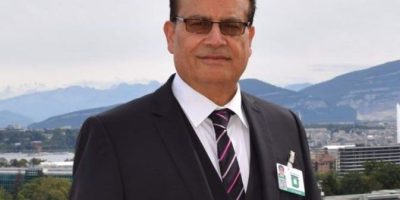No real winning for Pakistani politicians
The life of a Pakistani politician is fraught with life-threatening situations. In recent years, several high-profile politicians have been assassinated: former Prime Minister Benazir Bhutto in 2007, and Punjab Governor Salman Taseer and Minority Affairs Minister Shahbaz Bhatti in 2011. The dangerous trend has continued this month with the targeting of lower-profile candidates running for office in the upcoming May 11 parliamentary elections. In these instances, the Pakistani Taliban or religious extremists were the perpetrators, choosing their targets for either “un-Islamic” secular and progressive values or their perceived cooperation with the United States against Pakistani militants and in the war in Afghanistan.
Beyond the tragic loss of life, the assassinations have the added casualty of limiting the space within which Pakistani leaders can safely operate. Taliban attacks have pressured willing and able voices against extremism into silence on issues-such as minority rights, girls’ education, and trade with India-that Pakistani society must publicly debate in order to fully embrace and institutionalize them. Those who remain vocal do so at great personal and professional risk: Pakistan’s Ambassador to the United States Sherry Rehman faces charges in Pakistani courts for her support of revisions to the blasphemy law.
In the context of upcoming polls, even more worrisome is that the specter of assassination and violence could affect the election outcome, and potentially the representation of key Pakistani constituencies. Pakistani Taliban spokesman Ehsanullah Ehsan announced the group’s intention to target candidates and party workers affiliated with the ruling coalition’s Awami National Party (ANP), Pakistan People’s Party (PPP), and Muttahida Quami Movement (MQM). ANP and MQM candidates and activists have already been injured or killed-fear tactics intended to directly handicap the ruling coalition’s chances of returning to power.
Another side effect of the Pakistani Taliban’s killing spree is that the specific pressure on the ANP could skew the Pashtun vote. After the 2008 election, many had high hopes for the secular party based in the Pashtun-concentrated Khyber Pakhtunkhwa province. But even then security threats from the Pakistani Taliban prevented ANP from fully taking advantage of the mandate the voters had given it. ANP was viewed as a potential counter to the influence of religious parties like Jamiat-Ulema-e-Islam (JUI), which swept national and provincial elections during the Musharraf years as part of a coalition of religious parties known as the Muttahida Majlis-e-Amal.
The Pakistani Taliban’s renewed targeting of ANP could improve the chances of religious parties who have, in the past, shared common ideological ground with them. The influence of religious parties has typically been downplayed, but what they are selling might have a new buyer. A survey conducted by the British Council earlier this year revealed that 38 percent of Pakistani youth surveyed believed Islamic law is better suited for Pakistan than democracy.
But the Pakistani Taliban has also threatened some religious parties, such as JUI, for cooperation with the federal government. The real worry is not the return of religious parties but the disenfranchisement of Pakistani Pashtuns, who may decide to stay at home on election day to avoid violence. This is the last thing the Pakistani state needs in a province that borders the ungoverned tribal areas and where the notion of a greater Pashtun homeland-”Pashtunistan”-exists in spirit if not fully in practice. ANP also faces threats in Karachi, where the growing Pashtun population has become ensconced in the city’s gangland-style political culture. Any handicaps for Karachi’s Pashtuns in the upcoming elections could also potentially worsen the security situation there.
The PPP, which led the previous government with ANP as a coalition partner, faces similar challenges in reaching voters. President Asif Ali Zardari has been reluctant to participate in large public rallies during this campaign, and for good reason. The memory of the 2007 assassination of his wife, former Prime Minister Benazir Bhutto, following a rally in Rawalpindi is still fresh among PPP leadership. Fears of assassination have kept Zardari out of the public eye for most of his term and now limit how much his son Bilawal Bhutto, the PPP’s heir apparent, campaigns on behalf of the party as well.
Bhutto could have rallied the party’s base at a time when the PPP needs it the most. Besides the PPP stronghold of interior Sindh, nowhere else is PPP guaranteed to dominate. Voter outreach is especially critical in north and central Punjab, the traditional domain of the Pakistan Muslim League-Nawaz (PML-N) and where Imran Khan’s Pakistan Tehreek-e-Insaaf (PTI) has made inroads. Most elections analysts believe that if PTI can continue to tap into PML-N’s base of support, especially among urban educated youth, then PPP’s chances in Punjab are inadvertently strengthened. It can also benefit from the fact that the strength of PTI’s “tsunami” appears to be tapering off. If PPP can access voters who are falling off the PTI bandwagon, it could have a chance in chipping away at PML-N’s lead. But PPP cannot rely solely on PML-N’s failures or PTI’s wane.
For the time being, Pakistani Taliban threats continue to keep the most influential PPP politicians far from Punjab where it matters the most. Even more tragic is the possibility that ANP will be forced to boycott the elections. While much of the elections focus has been on the historic political transition afoot in Pakistan, the threats serve as a reminder of the tough road ahead for whoever manages to survive and come out on top.
Courtesy: Foreign Policy
Shamila N. Chaudhary is a South Asia analyst at the Eurasia Group and a senior fellow at the New America Foundation. She served as director for Pakistan and Afghanistan at the White House National Security Council from 2010-2011.
Related News

The Global Revolt Against Israel’s Genocide
By Qamar Bashir The world’s conscience has shifted. After months of pleading, protesting, and petitioningRead More

America’s Sanctions Spiral
By Qamar Bashir In a world already teetering on the edge of conflict, the UnitedRead More


Comments are Closed